$10,000 Grand Prize
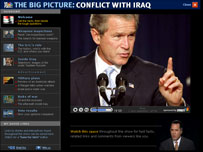 MSNBC.com, The Big Picture
MSNBC.com, The Big Picture
“MSNBC.com’s efforts set the high-water mark for fresh, interactive storytelling in American journalism. They are setting the pace. Now the rest of us have to catch up.” -Bryan Monroe, chair of the Batten Awards Board of Judges and assistant vice president/news at Knight Ridder.
This series of three guided tours on subjects ranging from Iraq to the Oscars and the 2002 Congressional elections integrated most every type of interactive content available today into a concise and well-presented packages. Video, audio, text, interviews, quizzes, polls, and games were just some of the tools that came together to give users the big-picture overview of the topic. “We tried to do a lot of merging of media, where we combined slide shows and videos and interactive sidbars and votes and feedback all in the same seamless place,” said Ashley Wells, senior interactive producer for MSNBC.com. “It’s kind of the dream, the holy grail of convergence.”
Said the Batten Award judges: “It’s got everything. It pulled together many tools and let users make choices, confront the information and do something with that information.”
The series, which was promoted through the MSNBC-TV network, received more than a million combined visitors over a matter of months despite requiring a broadband Internet connection and video software.
$2,500 Runners-Up
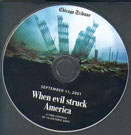 The Chicago Tribune, When Evil Struck America
The Chicago Tribune, When Evil Struck America
This CD-ROM time capsule was distributed to more than 1 million Chicago Tribune subscribers on the one-year anniversary of the Sept. 11, 2001 World Trade Center attacks. The project captured the national mood of the aftermath by combining interactive graphics, a timeline, video, audio, and the full text of dozens of Tribune newspaper articles and television packages into an easy-to-navigate package. Single-day street sales of the Tribune increased by 100,000 on the Sunday the project was included in the paper. Copies of the CD were also made available to schools, libraries, and individuals who requested them.
 Minnesota Public Radio, Budget Balancer
Minnesota Public Radio, Budget Balancer
This 19-page web exercise offered users 62 different cost-cutting and revenue-raising options to reduce the state’s $4.2 billion budget deficit. MPR’s Balancer set itself apart from similar projects through a colorful presentation filled with charts and special windows featuring informative “Headlines” and “Look Out!” warnings that added context to the process. Seven thousand participants submitted 11,000 budgets during the project’s run of about two months. The project helped MPR attract a younger audience, one that usually doesn’t listen to public radio. Forty-three percent of the participants were age 30 or younger. Responses helped to guide MPR’s budget coverage to new topics.
Honorable Mentions
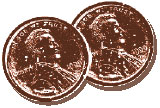 The San Francisco Chronicle, The Two Cents Project
The San Francisco Chronicle, The Two Cents Project
This “virtual man-on-the-street” effort built a database of more than 1,450 “field correspondents” to contribute their two cents on a variety of issues. The contacts were quoted in articles, used to gather breaking news and featured on the Op-ed page. Besides helping the paper keep in better touch with its readers, the project generated story ideas and helped reporters find knowledgable sources apart from the usual stable of experts and officials.
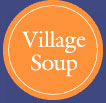 VillageSoup.com
VillageSoup.com
This Web hub for three Maine community sites put a local spin on interactive news. Local news (often generated by community residents), opinions, and picture galleries are mixed with message boards and polls that let visitors have their say. The site also provides local business information and event listings. It is now partnered with a newspaper, launched in September 2003.
Public Broadcasting System – Wide Angle
“Six billion people. 200 nations. Somebody’s got to cover it.” So goes the slogan for this PBS series, launched in July 2002, which examines stories from around the world. The accompanying Web site features more in-depth information and interactive content such as time lines, interactive maps and polls that add a different dimension to the stories.
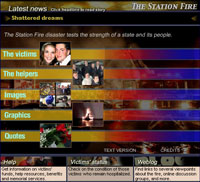 The Providence Journal – The Station Fire Digital Extra
The Providence Journal – The Station Fire Digital Extra
Through animated graphics, pictures, text, video and quotes, the Providence Journal tells how over 100 people lost their lives when The Station dance club caught on fire. Each victim of the blaze is remembered through an obituary while a bulletin board lets visitors share their thoughts about the tragedy. A news ticker and Weblog round out the package. Launched in February 2003.
 Orange County Register – The Boy Monk
Orange County Register – The Boy Monk
This striking online version of a print feature, launched in January 2003, tells the tale of a 12-year-old Vietnamese boy who was born in California but traveled to India to become a Buddhist monk. The story is told through text, video, audio, graphics and an interactive gallery.
 WFAA-TV (ABC) Dallas/Forth Worth – Tragedy over Texas
WFAA-TV (ABC) Dallas/Forth Worth – Tragedy over Texas
Launched in February 2003, this searchable database of images and eyewitness accounts chronicles the Columbia shuttle disaster. An accompanying CD-ROM features video and text news reports as the story unfolded as well as archived pictures and editorials about the disaster.
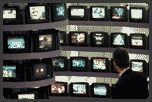 The NewsHour with Jim Lehrer – Merging Media: How Relaxing Ownership Rules has Affected the Media
The NewsHour with Jim Lehrer – Merging Media: How Relaxing Ownership Rules has Affected the Media
An online companion to a June 2002 NewsHour feature, Merging Media assembles data and reports about the media ownership debate. The Web site goes over the rules that had dictated media ownership across the country and details how the new rules would change them. An interactive map of local media ownership in the biggest markets breaks the issue down to the local level, and video excerpts complete the multimedia package.
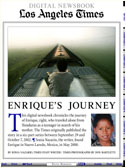 Kent State University, Institute for CyberInformation – Digital Newsbooks (PDF)
Kent State University, Institute for CyberInformation – Digital Newsbooks (PDF)
The Digital Newsbook concept, developed at Kent State, affords newspapers with an innovative new vehicle for widely disseminating series and other in-depth stories in a visually rich interactive format that blends the familiar page-based attributes of traditional print with the hypermedia features of the Web. While the Digital Newsbook format was designed to take full advantage of the recently introduced pen-based Tablet PCs, it can be read comfortably on any contemporary computer monitor. A pilot Digital Newsbook titled Enrique’s Journey was created at ICI for the Los Angeles Times in November 2002. The contents derive from a six-part series by the same name published in the Los Angeles Times between Sept. 29, 2002 and Oct. 7, 2002.
 The Philadelphia Inquirer – Redevelopment of Penn’s Landing
The Philadelphia Inquirer – Redevelopment of Penn’s Landing
This print and Web series, launched in August 2002, helped readers understand choices involved in three different development proposals for the waterfront real estate known as Penn’s Landing. Through discussion forums hosted by the paper and online renderings of development designs that visitors could vote on, readers registered their opinions with the city planners. Articles and editorials about the progress kept the public informed about the fate of the waterfront, while online polls, time lines and photo galleries provided content exclusive to the web.
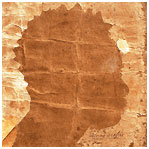 The Hartford Courant – Complicity
The Hartford Courant – Complicity
The Courant’s special print feature and accompanying Web site, launched in September 2002, detail Connecticut’s unspoken, complicit acceptance of goods and services that slavery helped produce. Interactive graphics, audio and videos clips and a searchable database of Connecticut slave owners provide information in ways that the newspaper feature alone could not.
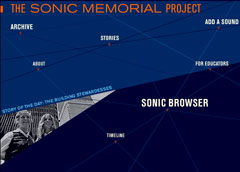 NPR – The Sonic Memorial Project
NPR – The Sonic Memorial Project
The tragic story of the World Trade Center is told through hundreds of audio clips—news reports, poetry, songs, voice mails and more—on a site that is part documentary and part memorial. The Sonic Browser provides a unique visual representation of the sea of sound floating about the site. Visitors are invited to call in and add their stories to the archive. Launched in September, 2002.
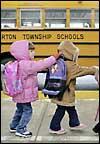 The Philadelphia Inquirer – 2003 School Report Card
The Philadelphia Inquirer – 2003 School Report Card
A comprehensive Web package, launched in March 2003, chronicles how Philadelphia-area public and private schools stack up against each other in the region. A searchable database lets users compare schools and districts by criteria such as number of teachers, average class size and SAT scores. Features such as sample standardized tests and a Web-chat with an expert are integrated with traditional, newspaper-style reporting in the package.
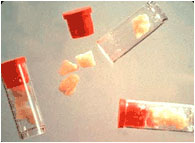 BET.com – Crack: Up in Smoke
BET.com – Crack: Up in Smoke
In November 2002, BET.com offered in-depth articles examining crack from a variety of angles, from the drug’s influence on popular entertainment to the social effects of crack babies and stiff drug sentencing. A flash animation shows crack’s effects on the body. Message boards and audio and video clips round out the multimedia package.
 WBUR-FM Boston – Vote by Issue Quiz
WBUR-FM Boston – Vote by Issue Quiz
t can be hard to learn candidates’ positions on the issues amid their carefully controlled media “images.” In this Web-based game, launched in October 2002, users pick the statements they most agree with on a variety of issues without knowing which candidate actually said them. At the end of the quiz, users finds out which candidate or candidates match their opinions on each issue and can follow links to more information on the candidates’ platforms.
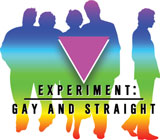 WFLD (FOX 32) Chicago – The Experiment: Gay and Straight
WFLD (FOX 32) Chicago – The Experiment: Gay and Straight
In July 2002, Fox affiliate WFLD in Chicago selected 10 people—young, old, male, female, gay and straight—to live in the same house for a week for this reality-TV experiment on homosexual relations in America. The series, broadcast in nightly installments with the news, features the housemates’ frank conversations on topics ranging from gays in the military to AIDS. Viewers had the chance to weigh in on who got to live in the house and could directly e-mail the housemates throughout the series.






